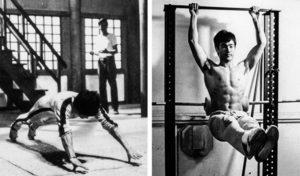
Bruce Lee, a name synonymous with martial arts excellence and an epitome of physical fitness, carved a legacy that transcends generations.
His rippling muscles and explosive power were products of a meticulously crafted workout regimen that has intrigued fitness enthusiasts worldwide.
This detailed exploration dives into the core of Lee’s training philosophy, unveiling the secrets behind his remarkable physique and strength.
Join us as we dissect the Bruce Lee workout routine that sculpted a body as iconic as the man himself.
The Essence of Bruce Lee’s Training Philosophy
Bruce Lee’s philosophy transcended the physical realm, blending mental fortitude with rigorous training. His holistic approach integrated diverse elements from weight training to martial arts, ensuring each muscle fiber was honed to perfection. Lee’s workouts were not just about bulking up but about creating a harmonious physique that could move with precision, speed, and grace. He believed in the principle of “using no way as way,” which applied to his fluid and adaptive training style.
Dissecting the Bruce Lee Workout Routine
At the heart of Lee’s routine were seven categories: Strength, Flexibility, Cardio, Martial Arts, Nutrition, Recovery, and Philosophy.
Strength Training:
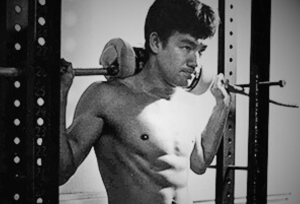
Lee’s weight training wasn’t focused on lifting maximum weights but on maximizing muscular endurance and explosive power. His sessions included compound movements like deadlifts and clean and presses, along with isolation exercises such as curls and tricep extensions.
Flexibility Training:
Lee’s awe-inspiring flexibility was achieved through dedicated stretching routines. His ability to perform splits and high kicks was a testament to his flexibility regimen.
Bruce Lee’s flexibility routines were as disciplined as they were diverse. He would start with basic stretches and gradually move to dynamic movements, ensuring his muscles were limber and responsive.
He didn’t consider flexibility just a means to prevent injury, but as a vital component of his fighting efficiency, allowing for an unparalleled range of motion in his attacks and defenses.
Daily practice included static holds, yoga-like postures, and dynamic kicking drills, all of which contributed to his almost supernatural agility.
Cardiovascular Training:
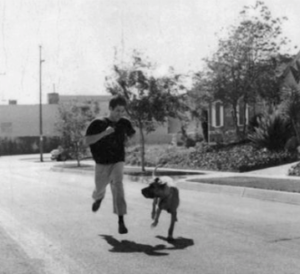
Lee incorporated running, skipping, and even shadowboxing as part of his cardio routine to build stamina that could sustain prolonged martial arts duels.
To build the extraordinary endurance Bruce Lee was known for, he took a multifaceted approach to cardiovascular training. His regimen went beyond traditional running; he would often run in sprints to mimic the bursts of energy required in combat.
Skipping rope wasn’t just a warm-up; it was a coordination drill, syncing his mind and body. Shadowboxing was another staple, serving dual purposes of refining his striking skills and elevating his heart rate.
This variety kept his workouts engaging and closely tied to his martial arts.
Martial Arts Training:
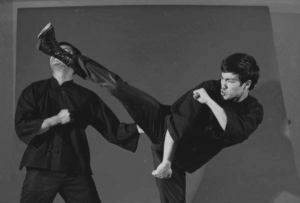
His martial arts practice was extensive, encompassing skills development in Jeet Kune Do, Wing Chun, and other forms, focusing on perfecting technique, speed, and reflexes.
Bruce Lee’s martial arts training was an evolving journey. He didn’t confine himself to the rigidity of one style, believing in adaptability over form.
His training sessions were intense, sometimes lasting for hours, as he honed the fluid movements of Jeet Kune Do, the precision of Wing Chun, and the power of traditional karate and boxing. He would meticulously break down each technique, from punches to kicks to blocks, drilling them until they were second nature.
Nutrition:

Bruce Lee’s diet was a forward-thinking regimen that prioritized whole, unprocessed foods to maximize his physical conditioning and mental clarity.
He structured his meals to provide sustained energy, incorporating a balanced mix of protein, fats, and carbohydrates. Proteins were predominantly sourced from white meat like chicken and fish, which are high in nutrients and low in fat.
His carbohydrate choices often included nutrient-dense options such as noodles made from whole grains and an array of vegetables, each selected for their specific health benefits.
Lee was particularly vigilant about avoiding refined sugars and processed foods, believing that such additives could detract from his physical performance and well-being.
His approach to eating was not just about maintaining his physique but was also seen as vital to his mental discipline and focus, embodying the principle that a sound body houses a sound mind.
Recovery:
Understanding the importance of rest, Lee included active recovery in his routine, often employing massages and stretching to aid muscle recovery.
Lee was an early adopter of the concept that muscles grow outside the gym. He prioritized sleep, understanding its role in physical and cognitive recovery.
Active rest days were common when he would engage in lighter, less intensive workouts, allowing his body to recuperate without stagnating.
Techniques like self-massage, foam rolling, and stretching sessions were not only for recovery but also to maintain the flexibility he valued so much.
Philosophical Training:
Mental conditioning played a significant role, with Lee dedicating time to meditation and reading, cultivating a warrior’s mindset.
Bruce Lee’s training extended beyond the physical into the realm of the mental and spiritual. He regularly allocated time for meditation to clear his mind and focus his thoughts, which he believed was as critical to martial arts as physical prowess.
Reading was also a significant part of his daily routine; he consumed texts on philosophy, psychology, and the art of war, weaving their teachings into his life and practice. Later writing a series of books dedicated to his craft, philosophy, and martial arts. Lee’s philosophy was about the totality of the human experience — mind, body, and spirit in unity.
Bruce Lee’s Workout Plan: Daily & Weekly Breakdown
A typical day for Lee started with meditation followed by a run. His afternoons were reserved for weight training or martial arts practice, with evenings often spent teaching or refining his techniques.
His weekly schedule was diverse, alternating between focused strength training, skill development, and endurance workouts.
He tailored his workouts frequently, ensuring his body and mind remained sharp and adaptable.
The Dragon’s Diet & Nutrition

Bruce Lee’s approach to nutrition was intricately aligned with his overall fitness philosophy, emphasizing not only the quality but the energetic and nutritional balance of his meals.
Rooted in traditional Chinese dietary principles, he focused on the yin and yang of food, ensuring that each meal was a balanced mix of macronutrients.
His carbohydrate intake primarily included complex sources like brown rice and whole grains, which were crucial for maintaining his energy levels through long training sessions.
Proteins were carefully selected from lean meats and seafood, supporting muscle synthesis and recovery.
Unlike many athletes of his time, Lee also paid close attention to micronutrient intake, incorporating a wide variety of vegetables to meet his vitamin and mineral needs.
Hydration was a critical aspect of his regimen, with a strong preference for natural water and herbal teas, which he believed supported both digestion and mental focus.
Bruce Lee’s Core Workout
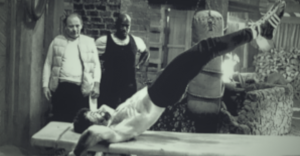
Bruce Lee’s core workouts were legendary, designed not only to enhance his martial arts performance but also to achieve an aesthetically pleasing six-pack. His routine included a variety of high-intensity exercises that targeted every angle of the abdominal muscles.
The Dragon Flag, one of the most challenging exercises, required extreme core strength and control as he would lift his entire body parallel to the ground from a lying position, using only his upper back for support.
Oblique crunches and leg raises were also integral, focusing on the side muscles and lower abdominals, respectively.
Lee’s approach was to perform these exercises with high repetition and precision, pushing his muscular endurance to the limits and ensuring that every muscle fiber was engaged.
Training Tools and Equipment

Bruce Lee’s training space, Hak Keung Gymnasium, was outfitted with a mix of conventional and unconventional training tools that allowed him to push the boundaries of traditional fitness routines.
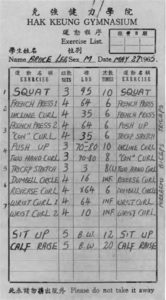
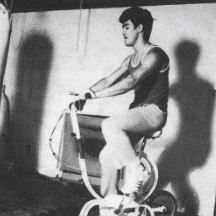
While he used standard equipment like dumbbells for strength training and barbells for powerlifting exercises, he also incorporated innovative tools such as the Electro-Isotron. This device, ahead of its time, used electrical impulses to stimulate muscle groups, enhancing muscular contraction and promoting strength gains without additional strain.
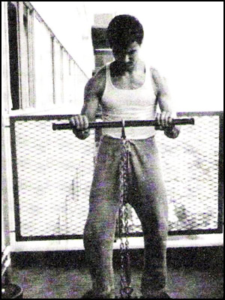
Additionally, Lee experimented with homemade equipment; for example, he modified punching bags with different fillings to vary their resistance and used timing devices to measure his speed and reaction times, constantly seeking ways to improve his physical capabilities through technological and methodological innovations.
Conclusion
Bruce Lee’s training, distilled into a relentless pursuit of physical and mental excellence, remains timeless. His routines reflect a balance of power, agility, and philosophical depth, offering a blueprint for anyone looking to excel not just in martial arts but in any physical and mental discipline.
For those interested in a deeper dive, here’s a link to a Bruce Lee workout PDF that outlines some of his iconic routines in detail. This resource serves as a practical guide for incorporating Lee’s methods into your own training regimen.
Additionally, explore his martial arts philosophy with this link to the “Tao of Jeet Kune Do” PDF, a crucial resource for understanding the depth of his martial arts ideology. These resources serve as practical guides for incorporating Lee’s methods into your own training regimen.
Sources:
The insights into Bruce Lee’s training were gathered from authoritative sources, including “The Art of Expressing the Human Body” by John Little, interviews with Lee’s contemporaries, and documented routines from Lee’s personal notes and training diaries.
